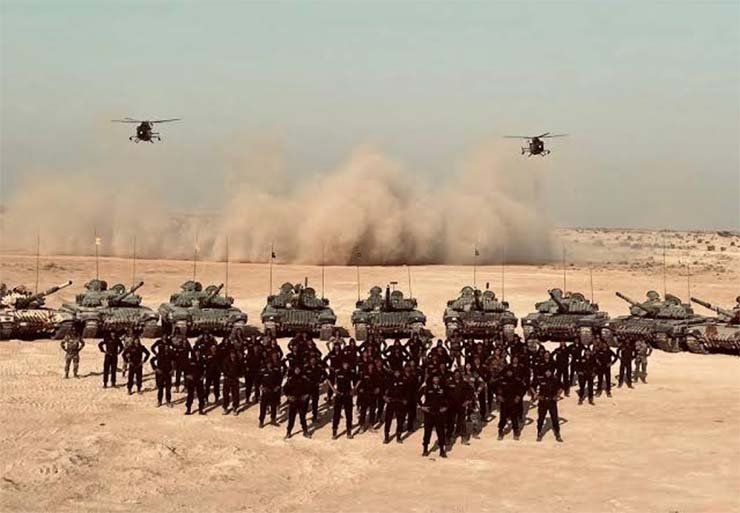Armoured vehicles have been a cornerstone of military capabilities for being decisive enablers in combat operations as mobile-protected lethal firepower. The key to their combat readiness lies in long-term fleet management, a robust upgradation philosophy and a sound sustenance plan.
Legacy to Contemporary Concept
There is a need to review the present legacy 30:40:30 (state of art: contemporary: obsolescence) concept and graduate to technology-empowered actionable concept of 40:30:20:10, meaning 40% state of the art (first quarter-life) which are fully modernised, 30% current (second quarter-life) contemporary but need subsystem product improvement and system upgrade/replacement, 20 % vintage (third quarter-life) which need platform upgrade, and 10% obsolescence (being phased out and replaced by next-generation AFV). The focus must be to push the second and third categories to the next higher category through modernisation/upgrades to achieve a higher weapon effectiveness index. Thus, from a legacy reactive theoretical approach, the need is to move to a proactive and actionable approach.
Long-Term Fleet Management Perspective
Lifecycle Management:
- Acquisition and Procurement: Strategic procurement plans must align with future operational requirements and technological advancements. This includes selecting vehicles that facilitate the commonality of platform and modular upgrades.
- Fleet Upgradation: Incorporating state-of-the-art technology like AI, autonomous capabilities, and advanced sensors enhances the vehicle’s operational capabilities and situational awareness. The focus must be platform-centric, not scheme-centric, with an eye on integration and minimum downtime.
- Maintenance and Sustainment: Implementing predictive maintenance models using data analytics can pre-emptively address potential issues, reducing downtime and extending vehicle life. Forecasting models through AI would go a long way for proactive and timely management.
- Decommissioning and Disposal: Efficiently retiring obsolete vehicles and recycling components ensures environmental compliance and cost savings. Further, refurbishing for alternate roles may be considered to optimise capabilities.
There is a need to review the present legacy and, while doing so, the focus must be to push the second and third categories to the next higher category through modernisation/upgrades to achieve a higher weapon effectiveness index. Thus, from a legacy reactive theoretical approach, the need is to move to a proactive and actionable approach
Fleet Composition and Diversity
- Standardisation Vs Specialisation: Balancing the standardisation of vehicles for ease of maintenance with the need for specialised vehicles for specific missions.
- Interoperability: Ensuring that different vehicle types within the fleet can operate together seamlessly in joint operations, enhancing overall mission effectiveness.
Training and Personnel
- Skilled Workforce: Continuous training programmes for personnel operating and maintaining the vehicles are crucial. This includes both technical training and tactical exercises with updated tools and concepts.
- Simulation and Virtual Training: Leveraging advanced simulators and AI-generated visual reality and augmented reality models to provide realistic training scenarios without the wear and tear on actual vehicles.
Upgradation Philosophy
The upgrades visualised at the development stage must be put through digital modelling, e-prototyping, and dynamic analysis integrated with the digital design of the basic platform. This would address the conflict zones for resolution and the challenges of power, weight and space management. There is also the need to clearly spell out the requirement of installation during the RFP, TEC and field evaluation stage. The responsibility of installation and work share of various agencies and all kinds of spares and infra requirements must be clarified at the CNC stage itself. The commonality of technologies, upgrades and platforms should also be encouraged. All upgrades planned must have the Indian OEM of that particular equipment as the principal lead integrator as the design is best known to them. Past experiences like ECU for BMP planned in isolation threw up challenges at a later stage. Thus, every five years, the production/maintenance intervention of the same product if required must be churned out with upgrades and a better weapon effectiveness index.
Classification of Upgrades. The upgrades should be classified as Platform Upgrades, System Upgrades, and Sub-System product Improvements. While the Platform and System upgrades will enhance the Weapon Effectiveness Index (WEI) of the equipment and are in true sense ‘upgrades’, the Sub-system product improvements are more to remove obsolescence (or marginally increase WEI).

The recommended classification of the upgrades is given below: –
| Sr No | Type | Time of Fd /Agency | Examples |
| (i) | Platform Upgrade | Mid-life/During Overhaul (OH) by Army Base Workshop, OEM | Power pack including Running Gear, Gun Barrel Assy, ‘Sys Upgrades’ (those available at that time) |
| (ii) | System Upgrades | Based on the Technology cycle/Army Base and Corps Zone Workshop | Fire Control System, NVDs, Networking Battlefield Management, Protection/Surveillance upgrades, Environmental control units, ERA panels. |
| (iii) | Sub-Sys Product Improvement | Technology Related/In situ or field loc | Auto Gear Shift, Digital Control, IFDSS, EW, EC or higher FPA TI Sight. |
Principles of Upgradation
Operational Need and Impact: The upgrade must be assessed for distinct capability enhancement in the operational capability of the weapon system. Sometimes to overcome obsolescence a system may be upgraded with new specifications like analog to digital.
Integrations and Management: There is a need for space, power and conflict management with other systems in the weapon system to ensure its seamless integration. Some variants like command tanks may require modified fitment and integration challenges to be overcome.
The upgrades visualised at the development stage must be put through digital modelling, e-prototyping, and dynamic analysis integrated with the digital design of the basic platform. This would address the conflict zones for resolution and the challenges of power, weight and space management. There is also the need to spell out the required installation during the RFP, TEC and field evaluation stage
Minimum Downtime: It is operationally imperative to have multipoint addressing of equipment to be upgraded as far as possible to field deployment to ensure early upgradation of the fleet and minimum downtime. Another aspect is the technology to fitment cycle which remains a challenge.
Training Aggregates and Supply Chain Management: Along with certain upgrades must come a training module or simulator modifications. Further, spare backup, training of technicians, setting up of labs like TIFCS and forward spare deployment are critical. Maintenance and life of upgrades must be institutionalised at the very outset.
Cost-benefit Vs Residual Life: The cost of the upgrade versus the balance life of equipment needs to be pragmatically assessed for cost benefit. Besides upgradation and scaling are interlinked to ensure the pragmatism of the budgetary envelope.
Harnessing Transition
To successfully execute the equipment philosophy, the transition through the three Cats should be managed by the upgrades and interventions. A recommended methodology is as follows:
- The first maintenance intervention (MR-1) should be planned towards the end of the Cat-I life of the AFVs/ICVs. At this stage, the product improvements/sub-system upgrades should be co-opted in sync with technology relevance as part of the revenue alteration committee.
- The second maintenance intervention (OH-1) should be planned mid-way through its Cat-II life to retain its ‘Contemporary’ status. All major platform upgrade projects should ensure modernisation aligned with this OH schedule. This would require to be implemented the capital procurement route. Ideally, the upgrades must be indigenous and if not ensure ToT under the Make in India route.
- A second MR (MR-2) should be planned to resuscitate equipment when it approaches Cat-III status with next-level product improvements/sub-system upgrades co-opted in sync with technology relevance.
The upgrades should be classified as Platform Upgrades, System Upgrades, and Sub-System product Improvements. While the Platform and System upgrades will enhance the Weapon Effectiveness Index (WEI) of the equipment and are in true sense ‘upgrades’, the Sub-system product improvements are more to remove obsolescence (or marginally increase WEI)
- Equipment planned to be retained beyond stipulated service life should undergo a comprehensive Life Extension Program (LEP – OH2), at mid-way through its Cat-III life, to upgrade it to ‘Contemporary’ status. The LEP should encompass all system/platform-related upgrades.
- The balance equipment, planned to be phased out at the end of stipulated service life, however, envisaged to serve longer could be resuscitated through an additional MR (MR-3) coinciding with the LEP.
- For seamless implementation, synergy should be ensured in the planning and provisioning of upgrade packages (co-aligned with basic and special maintenance interventions) between the capital procurement route and revenue route in a perspective manner as part of Fleet Mgt.
To Conclude
Long-term fleet management and a proactive upgradation philosophy are vital to maintaining a capable and ready-armoured vehicle fleet. By leveraging technological advancements, modular designs, and comprehensive training programmes, military forces can ensure their armoured vehicles remain effective and adaptable to future combat scenarios.
The need is to have a paradigm shift in the fleet management and upgradation philosophy from a ‘scheme’ based approach to a ‘platform’ based approach. Further, upgrade classification, intervention, execution, scope, and procurement route merit a de novo look based on a womb-to-tomb concept. The training aggregates and supply chain management besides technology upgradation cum intervention plan must be forethought and institutionalised.
-The author is a PVSM, AVSM, VSM has had an illustrious career spanning nearly four decades. A distinguished Armoured Corps officer, he has served in various prestigious staff and command appointments including Commander Independent Armoured Brigade, ADG PP, GOC Armoured Division and GOC Strike 1. The officer retired as DG Mechanised Forces in December 2017 during which he was the architect to initiate process for reintroduction of Light Tank and Chairman on the study on C5ISR for Indian Army. Subsequently he was Consultant MoD/OFB from 2018 to 2020. The Officer is a reputed defence analyst, a motivational speaker and prolific writer on matters of military, defence technology and national security.The views expressed are personal and do not necessarily carry the views of Raksha Anirveda
The author, a PVSM, AVSM, VSM has had an illustrious career spanning nearly four decades. A distinguished Armoured Corps officer, he has served in various prestigious staff and command appointments including Commander Independent Armoured Brigade, ADG PP, GOC Armoured Division and GOC Strike 1. The officer retired as DG Mechanised Forces in December 2017 during which he was the architect to initiate process for reintroduction of Light Tank and Chairman on the study on C5ISR for Indian Army. Subsequently he was Consultant MoD/OFB from 2018 to 2020. He is also a reputed defence analyst, a motivational speaker and prolific writer on matters of military, defence technology and national security. The views expressed are personal and do not necessarily carry the views of Raksha Anirveda





